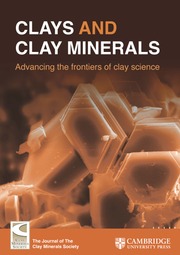Crossref Citations
This article has been cited by the following publications. This list is generated based on data provided by
Crossref.
Bickmore, Barry R.
Rosso, Kevin M.
Nagy, Kathryn L.
Cygan, Randall T.
and
Tadanier, Christopher J.
2003.
Ab Initio Determination of Edge Surface Structures for Dioctahedral 2:1 Phyllosilicates: Implications for Acid-Base Reactivity.
Clays and Clay Minerals,
Vol. 51,
Issue. 4,
p.
359.
Bickmore, Barry R.
Tadanier, Christopher J.
Rosso, Kevin M.
Monn, Will D.
and
Eggett, Dennis L.
2004.
Bond-valence methods for pKa prediction: critical reanalysis and a new approach.
Geochimica et Cosmochimica Acta,
Vol. 68,
Issue. 9,
p.
2025.
Hernández-Laguna, Alfonso
Escamilla-Roa, Elizabeth
Timón, Vicente
Dove, Martin T.
and
Sainz-Díaz, C. Ignacio
2006.
DFT study of the cation arrangements in the octahedral and tetrahedral sheets of dioctahedral 2:1 phyllosilicates.
Physics and Chemistry of Minerals,
Vol. 33,
Issue. 10,
p.
655.
Molina-Montes, Esther
Timón, Vicente
Hernández-laguna, Alfonso
and
Sainz-díaz, C. Ignacio
2008.
Dehydroxylation mechanisms in Al3+/Fe3+ dioctahedral phyllosilicates by quantum mechanical methods with cluster models.
Geochimica et Cosmochimica Acta,
Vol. 72,
Issue. 16,
p.
3929.
Xia, Liu-yin
Zhong, Hong
Liu, Guang-yi
and
Li, Xin-gang
2009.
Electron bandstructure of kaolinite and its mechanism of flotation using dodecylamine as collector.
Journal of Central South University of Technology,
Vol. 16,
Issue. 1,
p.
73.
Sainz-Díaz, C. Ignacio
2011.
Layered Mineral Structures and their Application in Advanced Technologies.
p.
203.
YONEDA, Minoru
SATOH, Masaya
MATSUI, Yasuto
and
SHIMADA, Yoko
2013.
ESTIMATION OF SECULAR CHANGE OF AIR DOSE RATE CAUSED BY RADIOACTIVE CESIUM POLLUTION IN URBAN LAND.
Journal of Japan Society of Civil Engineers, Ser. G (Environmental Research),
Vol. 69,
Issue. 3,
p.
126.
Shuller, Lindsay C.
Ewing, Rodney C.
and
Becker, Udo
2013.
Np-incorporation into uranyl phases: A quantum–mechanical evaluation.
Journal of Nuclear Materials,
Vol. 434,
Issue. 1-3,
p.
440.
Okumura, Masahiko
Nakamura, Hiroki
and
Machida, Masahiko
2013.
Mechanism of Strong Affinity of Clay Minerals to Radioactive Cesium: First-Principles Calculation Study for Adsorption of Cesium at Frayed Edge Sites in Muscovite.
Journal of the Physical Society of Japan,
Vol. 82,
Issue. 3,
p.
033802.
Shuller-Nickles, Lindsay
Bender, Will
Walker, Sarah
and
Becker, Udo
2014.
Quantum-Mechanical Methods for Quantifying Incorporation of Contaminants in Proximal Minerals.
Minerals,
Vol. 4,
Issue. 3,
p.
690.
Cygan, Randall T.
2015.
Geochemistry of Soil Radionuclides.
p.
87.
Fuller, Adam J.
Shaw, Samuel
Ward, Michael B.
Haigh, Sarah J.
Mosselmans, J. Frederick W.
Peacock, Caroline L.
Stackhouse, Stephen
Dent, Andrew J.
Trivedi, Divyesh
and
Burke, Ian T.
2015.
Caesium incorporation and retention in illite interlayers.
Applied Clay Science,
Vol. 108,
Issue. ,
p.
128.
MOURI, Mitsuo
BABA, Naoki
TSUCHIDA, Mitsuru
and
NAKAJIMA, Takuma
2015.
GRAIN-SIZE DISTRIBUTION ANALYSIS OF RADIOCESIUM IN SOILS BY LOAD-CURVE TEST AND SURFACE-ADSORPTION MODELING.
Journal of Japan Society of Civil Engineers, Ser. G (Environmental Research),
Vol. 71,
Issue. 1,
p.
26.
Yu, Chol-Jun
Choe, Song-Hyok
Jang, Yong-Man
Jang, Gwang-Hyok
and
Pae, Yong-Hyon
2016.
First-principles study of organically modified muscovite mica with ammonium (NH $$_4^+$$ 4 + ) or methylammonium (CH $$_3$$ 3 NH $$_3^+$$ 3 + ) ion.
Journal of Materials Science,
Vol. 51,
Issue. 24,
p.
10806.
Kerisit, Sebastien
Okumura, Masahiko
Rosso, Kevin M.
and
Machida, Masahiko
2016.
Molecular Simulation of Cesium Adsorption at the Basal Surface of Phyllosilicate Minerals.
Clays and Clay Minerals,
Vol. 64,
Issue. 4,
p.
389.
Okumura, M.
Sassi, M.
Rosso, K. M.
and
Machida, M.
2017.
Origin of 6-fold coordinated aluminum at (010)-type pyrophyllite edges.
AIP Advances,
Vol. 7,
Issue. 5,
p.
055211.
Zhang, Chi
Liu, Xiandong
Lu, Xiancai
He, Mengjia
Jan Meijer, Evert
and
Wang, Rucheng
2017.
Surface complexation of heavy metal cations on clay edges: insights from first principles molecular dynamics simulation of Ni(II).
Geochimica et Cosmochimica Acta,
Vol. 203,
Issue. ,
p.
54.
Zheng, Qiushi
Zhang, Yimin
Liu, Tao
Huang, Jing
Xue, Nannan
and
Shi, Qihua
2017.
Optimal Location of Vanadium in Muscovite and Its Geometrical and Electronic Properties by DFT Calculation.
Minerals,
Vol. 7,
Issue. 3,
p.
32.
Loganathan, Narasimhan
and
Kalinichev, Andrey G.
2017.
Quantifying the Mechanisms of Site-Specific Ion Exchange at an Inhomogeneously Charged Surface: Case of Cs+/K+ on Hydrated Muscovite Mica.
The Journal of Physical Chemistry C,
Vol. 121,
Issue. 14,
p.
7829.
Sassi, Michel
Okumura, Masahiko
Machida, Masahiko
and
Rosso, Kevin M.
2017.
Transmutation effects on long-term Cs retention in phyllosilicate minerals from first principles.
Phys. Chem. Chem. Phys.,
Vol. 19,
Issue. 39,
p.
27007.

